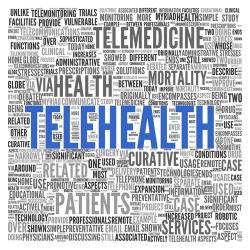Editor’s note: For more on this topic, see the February issue of Health Affairs, which features a series of articles on connected health.
Editor’s note: For more on this topic, see the February issue of Health Affairs, which features a series of articles on connected health.
 The nation’s ongoing battle to strike a delicate balance between increasing access to quality health care for all Americans and reducing overall health care spending just scored one of its most substantial victories. In late April, after several months of thoughtful and robust collaboration, the Federation of State Medical Boards (FSMB) ratified a new model national policy – the Appropriate Use of Telemedicine in the Practice of Medicine – at its annual meeting in Denver. This marks the first time the medical community has unilaterally acknowledged the impact technology has had on the practice of medicine, and the ability telemedicine — or connected health — has to facilitate and improve the delivery of health care.
The nation’s ongoing battle to strike a delicate balance between increasing access to quality health care for all Americans and reducing overall health care spending just scored one of its most substantial victories. In late April, after several months of thoughtful and robust collaboration, the Federation of State Medical Boards (FSMB) ratified a new model national policy – the Appropriate Use of Telemedicine in the Practice of Medicine – at its annual meeting in Denver. This marks the first time the medical community has unilaterally acknowledged the impact technology has had on the practice of medicine, and the ability telemedicine — or connected health — has to facilitate and improve the delivery of health care.
Let us first put this in perspective. We all know health care is at a critical juncture. The implementation of the Affordable Care Act means millions of newly eligible Americans will seek access to an already over-burdened health care system. The nation faces a serious shortage of primary care providers, specialty care is becoming more diversified, and access to care in rural areas is an ongoing challenge. All of these issues are on the rise.
Technology-enabled Care
Enter technology-enabled care. Real-time video encounters between patients and providers reverse the burden on patients to seek care in a hospital or doctor’s office by bringing health care directly to them, in their home. At the same time, remote monitoring, sensors, mobile health and other technologies are helping to reduce hospital readmissions, and improving adherence to care plans and clinical outcomes, as well as patient satisfaction. Connected health tools also support preventative care efforts for chronic care patients and can empower individuals to make positive lifestyle changes to improve their overall health and wellness.
Momentum for telehealth is accelerating at an undeniable rate. As of March, twenty states and the District of Columbia have passed mandates for coverage of commercially provided telehealth services; 46 states offer some type of Medicaid reimbursement for services provided via telehealth. A study by Deloitte predicts that this year alone, there will be 100 million eVisits globally, potentially saving over $5 billion when compared to the cost of face-to-face doctor visits. This represents a growth of 400 percent in video-based virtual visits from 2012 levels, and the greatest usage is predicted to occur in North America, where there could be up to 75 million visits in 2014. This would represent 25 percent of the addressable market.
Yet, there exists an inconsistent and often archaic patchwork of state laws that have inhibited the deployment of telehealth in both the private and public sectors. As a result, both providers and patients are in a state of limbo, prompting such questions as: Can I, as a provider, deliver care while still being compliant in all 50 states? Can I, as a patient, trust the care I receive via telehealth is safe and secure? These uncertainties have created an unnecessary barrier to realizing the true promise of telehealth.
Model Policy For Telemedicine Technologies
The Federation of State Medical Boards recently took action by forming the State Medical Boards Appropriate Regulation of Telemedicine (SMART) Workgroup. Through a thoughtful nearly year-long process which included a broad cross-section of stakeholders, the SMART Workgroup developed the “Model Policy for the Appropriate Use of Telemedicine Technologies in the Practice of Medicine.” This insightful document provides states with clear definitions and principles they can look to for guidance when developing new policies that govern telehealth.
Among these principles are these key concepts:
- Evaluation and Treatment of Patient. Treatment delivered in an online setting should be held to the same standard of appropriate practice as those in traditional settings.
- Establishing a Treatment Relationship Online. A physician-patient relationship can be established using telemedicine, so long as the standard of care is met.
- Online Prescribing Safeguards. Prescribing in a telehealth encounter should be at the discretion of the physician.
- Ensuring Privacy, Security, Documentation, and Continuity. Telehealth encounters should be HIPAA compliant, include informed consent, the generation of a medical record, and support continuity of care.
I applaud the Federation, the SMART Workgroup, and their guidance. Telehealth is happening; it’s becoming an accepted practice across the United States. This Model Policy allows for regulatory certainty while encouraging future innovation by creating clear definitions and guidelines on how and when telehealth can be most effectively incorporated into quality patient care.
States must now take action and adopt these policies. Failure to do so is not just inaction, it is irresponsible. The use of connected health tools will increase, and with thoughtful, modernized policy, providers and patients can be assured that technology-enabled care will be safe, secure and uphold a standard of quality care consistent with care delivered in person. The Federation has done its work as national leaders, and now it is time for state leaders to do their part to advance health care delivery in every state throughout the country.
This post first appeared in Health Affairs:
Joseph Kvedar, For Telehealth Patient Safety Insists Upon An Evolution In Policy, Health Affairs Blog, May 29th 2014, http://healthaffairs.org/blog/2014/05/29/for-telehealth-patient-safety-insists-upon-an-evolution-in-policy/
Copyright ©2010 Health Affairs by Project HOPE – The People-to-People Health Foundation, Inc.
telehealth / shutterstock








